Operations Management Analysis: A Case Study on Tesco Group
VerifiedAdded on 2021/02/19
|9
|2007
|23
Report
AI Summary
This report provides a comprehensive analysis of Tesco's operations management, focusing on its day-to-day activities, supply chain strategies, and the application of Total Quality Management (TQM) theory. It examines how Tesco integrates TQM principles to enhance customer satisfaction and improve productivity. The report delves into Tesco's value chain, exploring both primary and secondary activities, including inbound and outbound logistics, operations, marketing, sales, and procurement. It also highlights the role of human resource management, technological development, and infrastructure in supporting Tesco's operational success. The study concludes that Tesco's robust supply chain and value chain models have been instrumental in its global expansion and consumer retention, emphasizing the critical role of operations management in achieving long-term goals and competitive advantage. The report references key academic sources to support its findings.
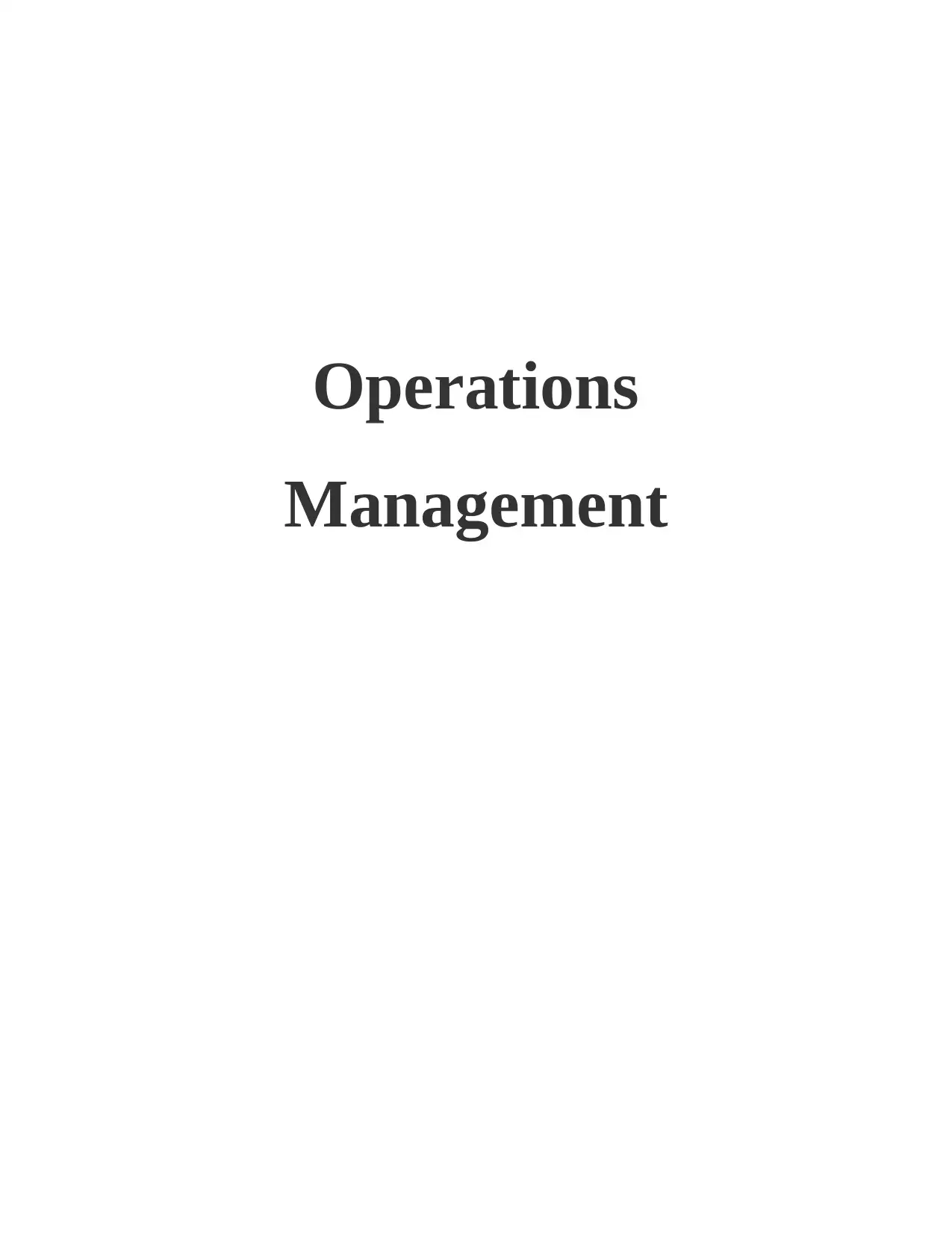
Operations
Management
Management
Paraphrase This Document
Need a fresh take? Get an instant paraphrase of this document with our AI Paraphraser
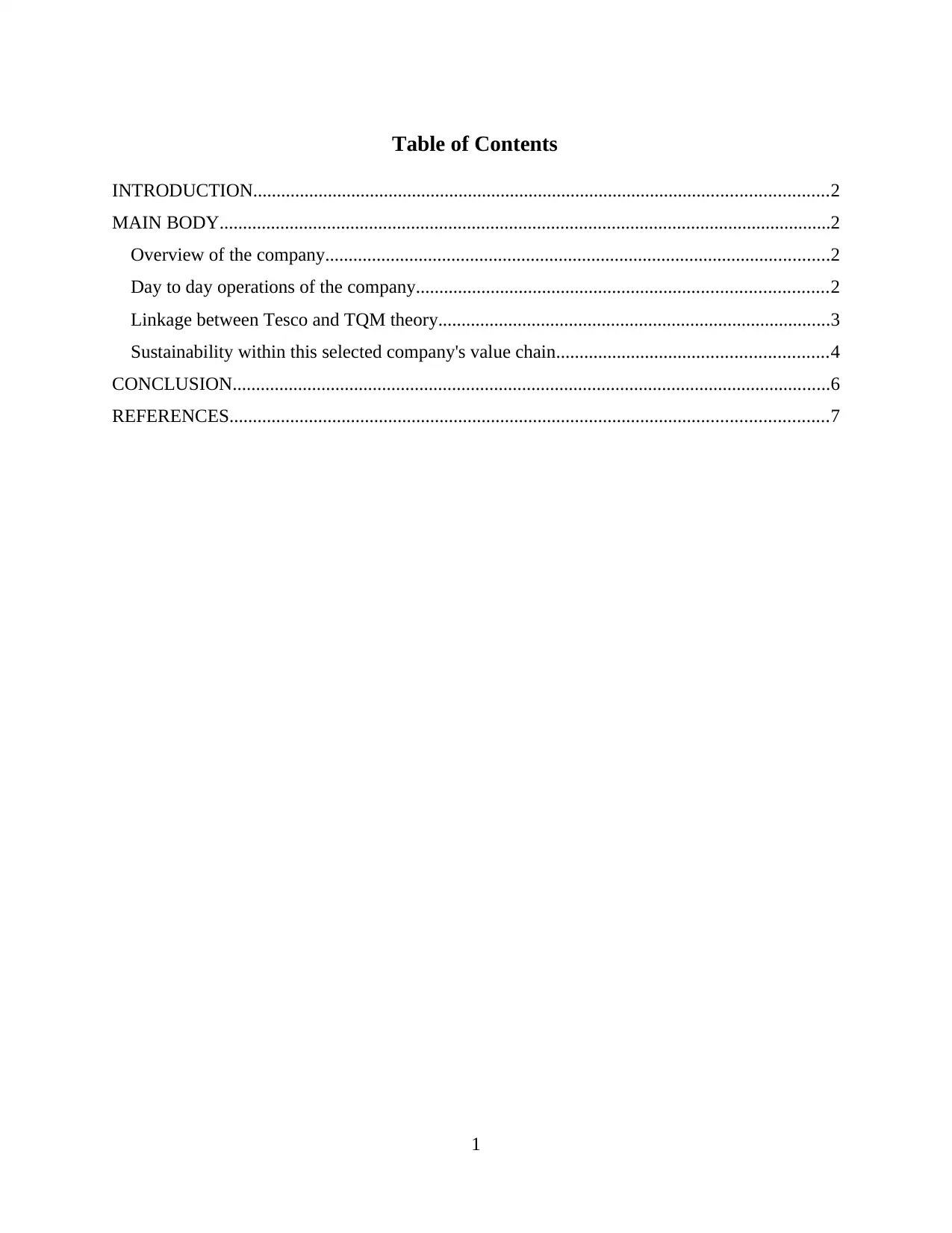
Table of Contents
INTRODUCTION...........................................................................................................................2
MAIN BODY...................................................................................................................................2
Overview of the company............................................................................................................2
Day to day operations of the company........................................................................................2
Linkage between Tesco and TQM theory....................................................................................3
Sustainability within this selected company's value chain..........................................................4
CONCLUSION................................................................................................................................6
REFERENCES................................................................................................................................7
1
INTRODUCTION...........................................................................................................................2
MAIN BODY...................................................................................................................................2
Overview of the company............................................................................................................2
Day to day operations of the company........................................................................................2
Linkage between Tesco and TQM theory....................................................................................3
Sustainability within this selected company's value chain..........................................................4
CONCLUSION................................................................................................................................6
REFERENCES................................................................................................................................7
1
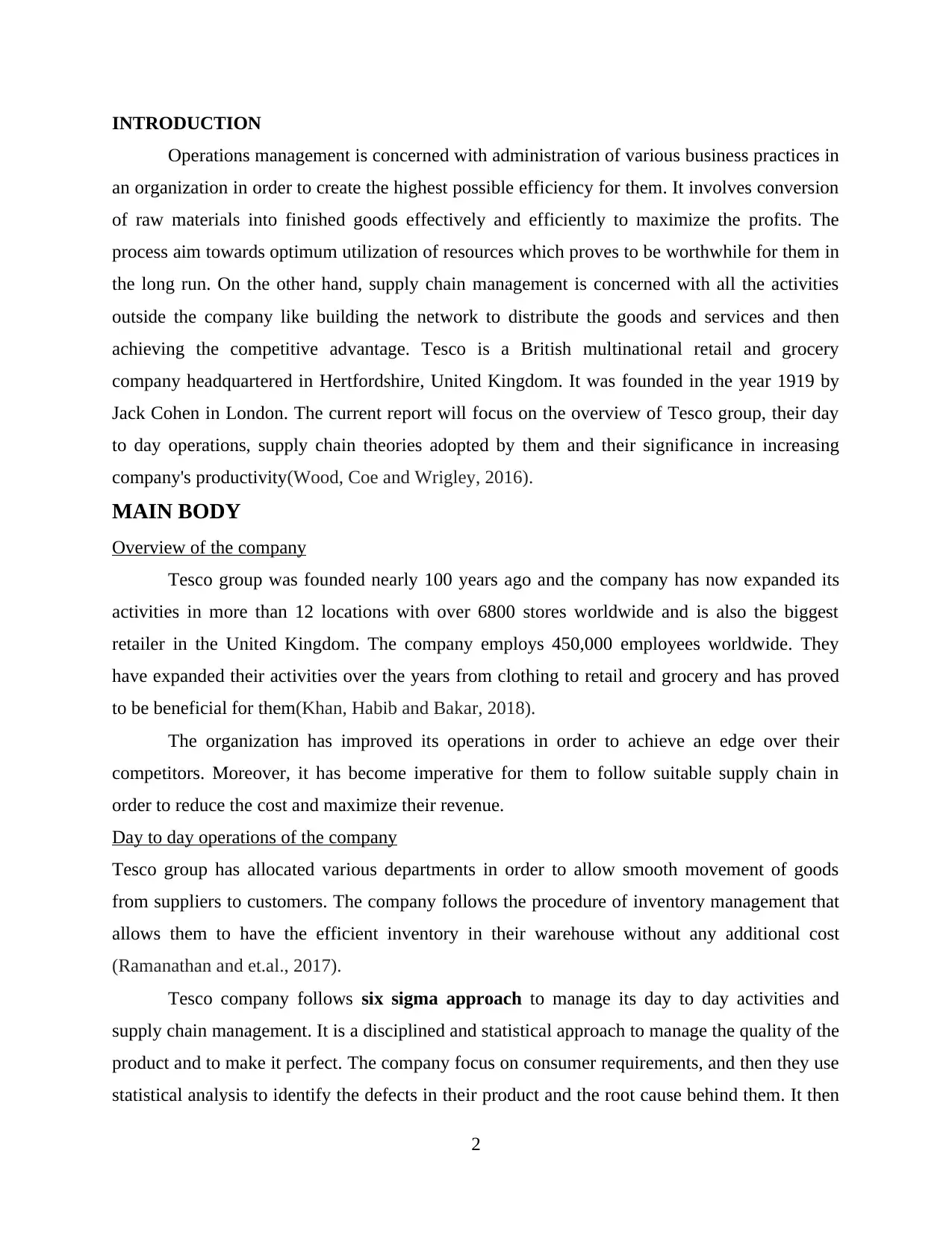
INTRODUCTION
Operations management is concerned with administration of various business practices in
an organization in order to create the highest possible efficiency for them. It involves conversion
of raw materials into finished goods effectively and efficiently to maximize the profits. The
process aim towards optimum utilization of resources which proves to be worthwhile for them in
the long run. On the other hand, supply chain management is concerned with all the activities
outside the company like building the network to distribute the goods and services and then
achieving the competitive advantage. Tesco is a British multinational retail and grocery
company headquartered in Hertfordshire, United Kingdom. It was founded in the year 1919 by
Jack Cohen in London. The current report will focus on the overview of Tesco group, their day
to day operations, supply chain theories adopted by them and their significance in increasing
company's productivity(Wood, Coe and Wrigley, 2016).
MAIN BODY
Overview of the company
Tesco group was founded nearly 100 years ago and the company has now expanded its
activities in more than 12 locations with over 6800 stores worldwide and is also the biggest
retailer in the United Kingdom. The company employs 450,000 employees worldwide. They
have expanded their activities over the years from clothing to retail and grocery and has proved
to be beneficial for them(Khan, Habib and Bakar, 2018).
The organization has improved its operations in order to achieve an edge over their
competitors. Moreover, it has become imperative for them to follow suitable supply chain in
order to reduce the cost and maximize their revenue.
Day to day operations of the company
Tesco group has allocated various departments in order to allow smooth movement of goods
from suppliers to customers. The company follows the procedure of inventory management that
allows them to have the efficient inventory in their warehouse without any additional cost
(Ramanathan and et.al., 2017).
Tesco company follows six sigma approach to manage its day to day activities and
supply chain management. It is a disciplined and statistical approach to manage the quality of the
product and to make it perfect. The company focus on consumer requirements, and then they use
statistical analysis to identify the defects in their product and the root cause behind them. It then
2
Operations management is concerned with administration of various business practices in
an organization in order to create the highest possible efficiency for them. It involves conversion
of raw materials into finished goods effectively and efficiently to maximize the profits. The
process aim towards optimum utilization of resources which proves to be worthwhile for them in
the long run. On the other hand, supply chain management is concerned with all the activities
outside the company like building the network to distribute the goods and services and then
achieving the competitive advantage. Tesco is a British multinational retail and grocery
company headquartered in Hertfordshire, United Kingdom. It was founded in the year 1919 by
Jack Cohen in London. The current report will focus on the overview of Tesco group, their day
to day operations, supply chain theories adopted by them and their significance in increasing
company's productivity(Wood, Coe and Wrigley, 2016).
MAIN BODY
Overview of the company
Tesco group was founded nearly 100 years ago and the company has now expanded its
activities in more than 12 locations with over 6800 stores worldwide and is also the biggest
retailer in the United Kingdom. The company employs 450,000 employees worldwide. They
have expanded their activities over the years from clothing to retail and grocery and has proved
to be beneficial for them(Khan, Habib and Bakar, 2018).
The organization has improved its operations in order to achieve an edge over their
competitors. Moreover, it has become imperative for them to follow suitable supply chain in
order to reduce the cost and maximize their revenue.
Day to day operations of the company
Tesco group has allocated various departments in order to allow smooth movement of goods
from suppliers to customers. The company follows the procedure of inventory management that
allows them to have the efficient inventory in their warehouse without any additional cost
(Ramanathan and et.al., 2017).
Tesco company follows six sigma approach to manage its day to day activities and
supply chain management. It is a disciplined and statistical approach to manage the quality of the
product and to make it perfect. The company focus on consumer requirements, and then they use
statistical analysis to identify the defects in their product and the root cause behind them. It then
2
⊘ This is a preview!⊘
Do you want full access?
Subscribe today to unlock all pages.

Trusted by 1+ million students worldwide
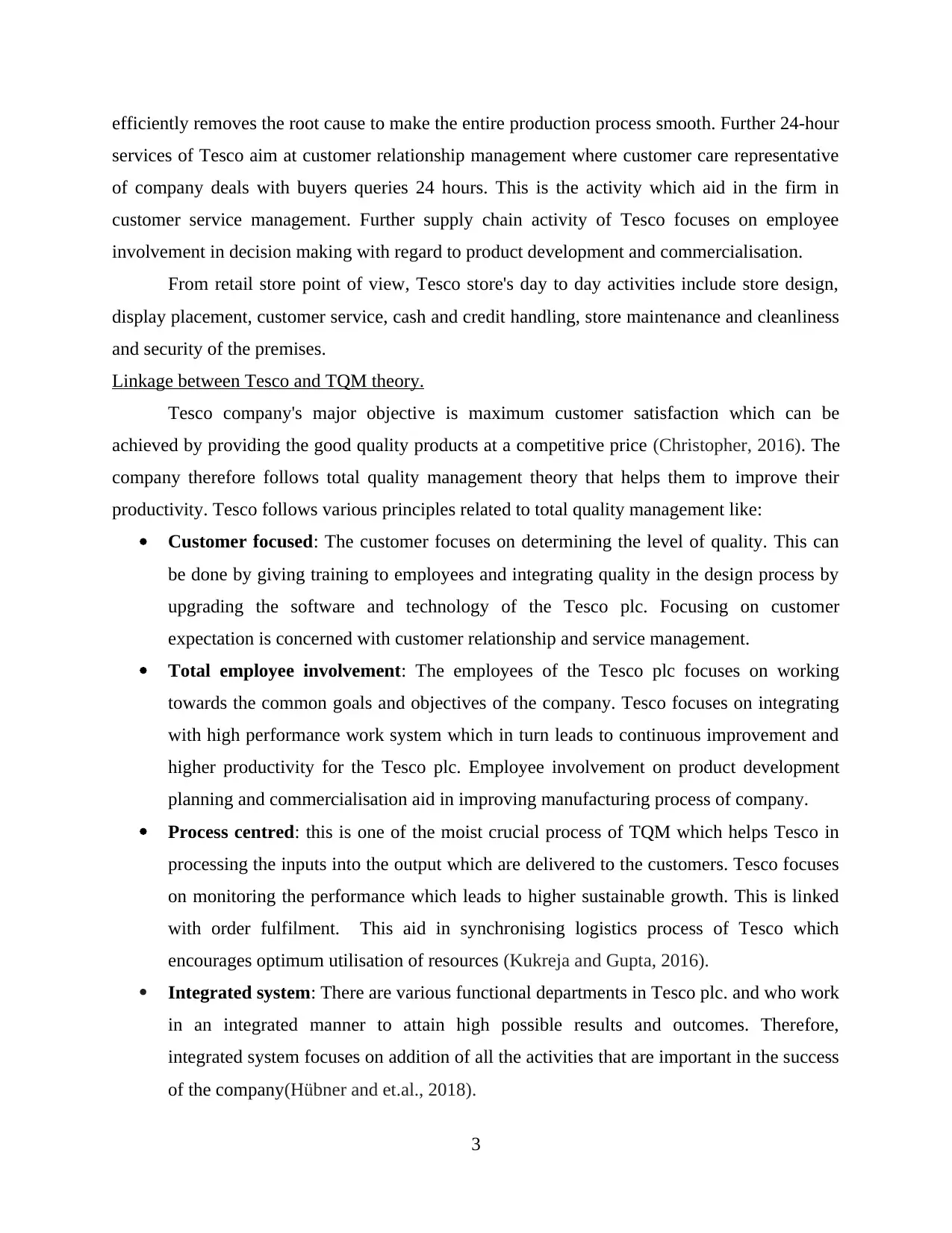
efficiently removes the root cause to make the entire production process smooth. Further 24-hour
services of Tesco aim at customer relationship management where customer care representative
of company deals with buyers queries 24 hours. This is the activity which aid in the firm in
customer service management. Further supply chain activity of Tesco focuses on employee
involvement in decision making with regard to product development and commercialisation.
From retail store point of view, Tesco store's day to day activities include store design,
display placement, customer service, cash and credit handling, store maintenance and cleanliness
and security of the premises.
Linkage between Tesco and TQM theory.
Tesco company's major objective is maximum customer satisfaction which can be
achieved by providing the good quality products at a competitive price (Christopher, 2016). The
company therefore follows total quality management theory that helps them to improve their
productivity. Tesco follows various principles related to total quality management like:
Customer focused: The customer focuses on determining the level of quality. This can
be done by giving training to employees and integrating quality in the design process by
upgrading the software and technology of the Tesco plc. Focusing on customer
expectation is concerned with customer relationship and service management.
Total employee involvement: The employees of the Tesco plc focuses on working
towards the common goals and objectives of the company. Tesco focuses on integrating
with high performance work system which in turn leads to continuous improvement and
higher productivity for the Tesco plc. Employee involvement on product development
planning and commercialisation aid in improving manufacturing process of company.
Process centred: this is one of the moist crucial process of TQM which helps Tesco in
processing the inputs into the output which are delivered to the customers. Tesco focuses
on monitoring the performance which leads to higher sustainable growth. This is linked
with order fulfilment. This aid in synchronising logistics process of Tesco which
encourages optimum utilisation of resources (Kukreja and Gupta, 2016).
Integrated system: There are various functional departments in Tesco plc. and who work
in an integrated manner to attain high possible results and outcomes. Therefore,
integrated system focuses on addition of all the activities that are important in the success
of the company(Hübner and et.al., 2018).
3
services of Tesco aim at customer relationship management where customer care representative
of company deals with buyers queries 24 hours. This is the activity which aid in the firm in
customer service management. Further supply chain activity of Tesco focuses on employee
involvement in decision making with regard to product development and commercialisation.
From retail store point of view, Tesco store's day to day activities include store design,
display placement, customer service, cash and credit handling, store maintenance and cleanliness
and security of the premises.
Linkage between Tesco and TQM theory.
Tesco company's major objective is maximum customer satisfaction which can be
achieved by providing the good quality products at a competitive price (Christopher, 2016). The
company therefore follows total quality management theory that helps them to improve their
productivity. Tesco follows various principles related to total quality management like:
Customer focused: The customer focuses on determining the level of quality. This can
be done by giving training to employees and integrating quality in the design process by
upgrading the software and technology of the Tesco plc. Focusing on customer
expectation is concerned with customer relationship and service management.
Total employee involvement: The employees of the Tesco plc focuses on working
towards the common goals and objectives of the company. Tesco focuses on integrating
with high performance work system which in turn leads to continuous improvement and
higher productivity for the Tesco plc. Employee involvement on product development
planning and commercialisation aid in improving manufacturing process of company.
Process centred: this is one of the moist crucial process of TQM which helps Tesco in
processing the inputs into the output which are delivered to the customers. Tesco focuses
on monitoring the performance which leads to higher sustainable growth. This is linked
with order fulfilment. This aid in synchronising logistics process of Tesco which
encourages optimum utilisation of resources (Kukreja and Gupta, 2016).
Integrated system: There are various functional departments in Tesco plc. and who work
in an integrated manner to attain high possible results and outcomes. Therefore,
integrated system focuses on addition of all the activities that are important in the success
of the company(Hübner and et.al., 2018).
3
Paraphrase This Document
Need a fresh take? Get an instant paraphrase of this document with our AI Paraphraser
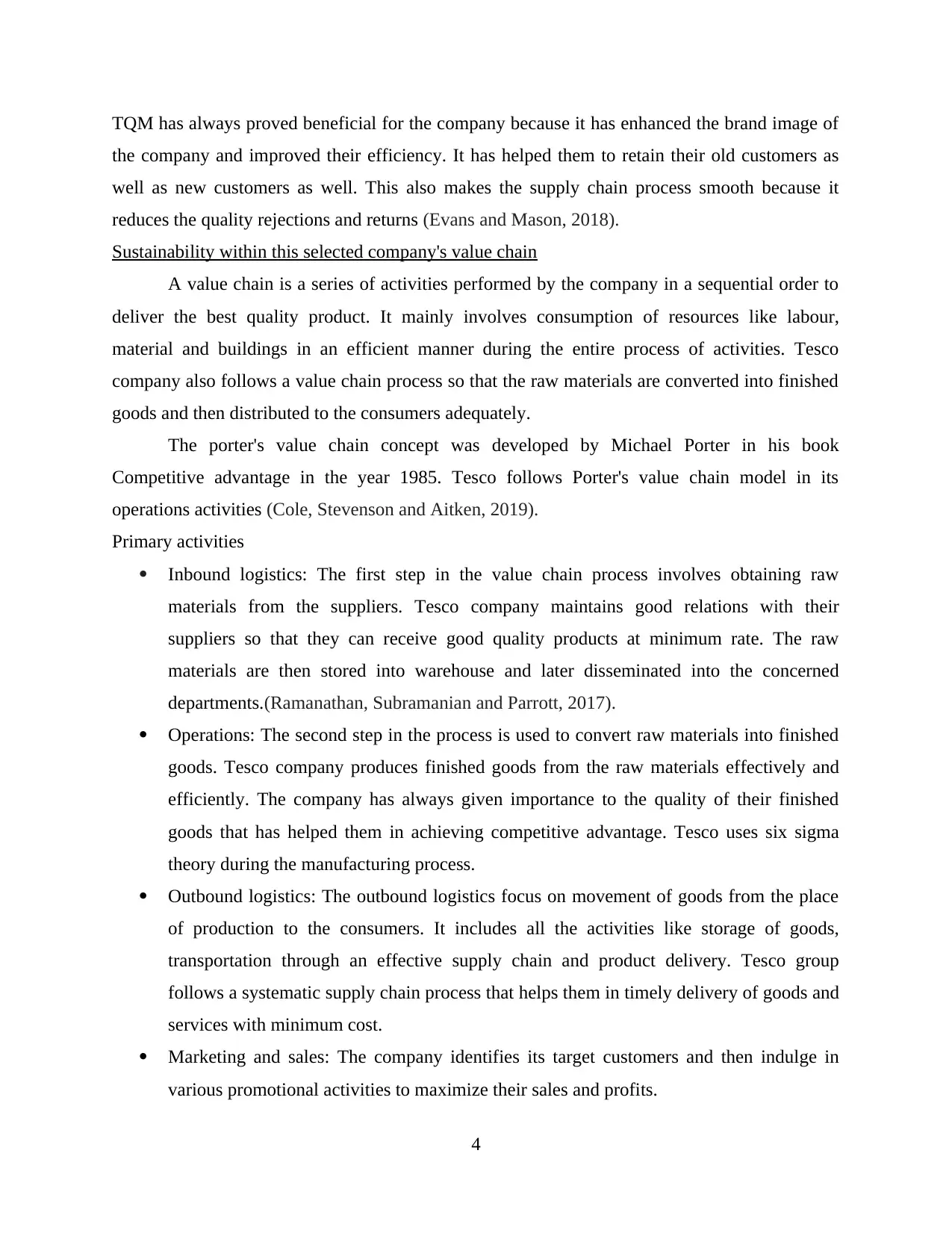
TQM has always proved beneficial for the company because it has enhanced the brand image of
the company and improved their efficiency. It has helped them to retain their old customers as
well as new customers as well. This also makes the supply chain process smooth because it
reduces the quality rejections and returns (Evans and Mason, 2018).
Sustainability within this selected company's value chain
A value chain is a series of activities performed by the company in a sequential order to
deliver the best quality product. It mainly involves consumption of resources like labour,
material and buildings in an efficient manner during the entire process of activities. Tesco
company also follows a value chain process so that the raw materials are converted into finished
goods and then distributed to the consumers adequately.
The porter's value chain concept was developed by Michael Porter in his book
Competitive advantage in the year 1985. Tesco follows Porter's value chain model in its
operations activities (Cole, Stevenson and Aitken, 2019).
Primary activities
Inbound logistics: The first step in the value chain process involves obtaining raw
materials from the suppliers. Tesco company maintains good relations with their
suppliers so that they can receive good quality products at minimum rate. The raw
materials are then stored into warehouse and later disseminated into the concerned
departments.(Ramanathan, Subramanian and Parrott, 2017).
Operations: The second step in the process is used to convert raw materials into finished
goods. Tesco company produces finished goods from the raw materials effectively and
efficiently. The company has always given importance to the quality of their finished
goods that has helped them in achieving competitive advantage. Tesco uses six sigma
theory during the manufacturing process.
Outbound logistics: The outbound logistics focus on movement of goods from the place
of production to the consumers. It includes all the activities like storage of goods,
transportation through an effective supply chain and product delivery. Tesco group
follows a systematic supply chain process that helps them in timely delivery of goods and
services with minimum cost.
Marketing and sales: The company identifies its target customers and then indulge in
various promotional activities to maximize their sales and profits.
4
the company and improved their efficiency. It has helped them to retain their old customers as
well as new customers as well. This also makes the supply chain process smooth because it
reduces the quality rejections and returns (Evans and Mason, 2018).
Sustainability within this selected company's value chain
A value chain is a series of activities performed by the company in a sequential order to
deliver the best quality product. It mainly involves consumption of resources like labour,
material and buildings in an efficient manner during the entire process of activities. Tesco
company also follows a value chain process so that the raw materials are converted into finished
goods and then distributed to the consumers adequately.
The porter's value chain concept was developed by Michael Porter in his book
Competitive advantage in the year 1985. Tesco follows Porter's value chain model in its
operations activities (Cole, Stevenson and Aitken, 2019).
Primary activities
Inbound logistics: The first step in the value chain process involves obtaining raw
materials from the suppliers. Tesco company maintains good relations with their
suppliers so that they can receive good quality products at minimum rate. The raw
materials are then stored into warehouse and later disseminated into the concerned
departments.(Ramanathan, Subramanian and Parrott, 2017).
Operations: The second step in the process is used to convert raw materials into finished
goods. Tesco company produces finished goods from the raw materials effectively and
efficiently. The company has always given importance to the quality of their finished
goods that has helped them in achieving competitive advantage. Tesco uses six sigma
theory during the manufacturing process.
Outbound logistics: The outbound logistics focus on movement of goods from the place
of production to the consumers. It includes all the activities like storage of goods,
transportation through an effective supply chain and product delivery. Tesco group
follows a systematic supply chain process that helps them in timely delivery of goods and
services with minimum cost.
Marketing and sales: The company identifies its target customers and then indulge in
various promotional activities to maximize their sales and profits.
4
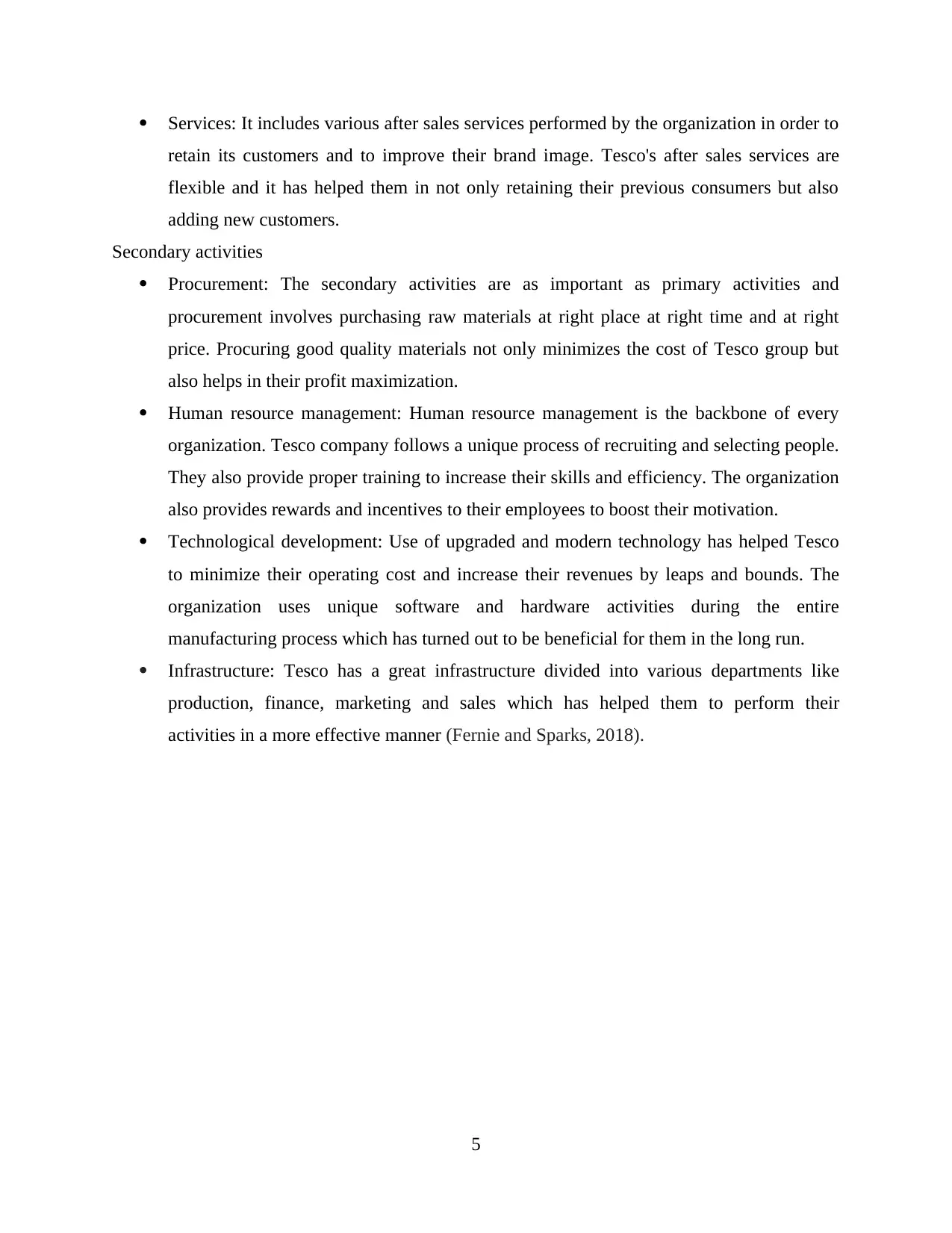
Services: It includes various after sales services performed by the organization in order to
retain its customers and to improve their brand image. Tesco's after sales services are
flexible and it has helped them in not only retaining their previous consumers but also
adding new customers.
Secondary activities
Procurement: The secondary activities are as important as primary activities and
procurement involves purchasing raw materials at right place at right time and at right
price. Procuring good quality materials not only minimizes the cost of Tesco group but
also helps in their profit maximization.
Human resource management: Human resource management is the backbone of every
organization. Tesco company follows a unique process of recruiting and selecting people.
They also provide proper training to increase their skills and efficiency. The organization
also provides rewards and incentives to their employees to boost their motivation.
Technological development: Use of upgraded and modern technology has helped Tesco
to minimize their operating cost and increase their revenues by leaps and bounds. The
organization uses unique software and hardware activities during the entire
manufacturing process which has turned out to be beneficial for them in the long run.
Infrastructure: Tesco has a great infrastructure divided into various departments like
production, finance, marketing and sales which has helped them to perform their
activities in a more effective manner (Fernie and Sparks, 2018).
5
retain its customers and to improve their brand image. Tesco's after sales services are
flexible and it has helped them in not only retaining their previous consumers but also
adding new customers.
Secondary activities
Procurement: The secondary activities are as important as primary activities and
procurement involves purchasing raw materials at right place at right time and at right
price. Procuring good quality materials not only minimizes the cost of Tesco group but
also helps in their profit maximization.
Human resource management: Human resource management is the backbone of every
organization. Tesco company follows a unique process of recruiting and selecting people.
They also provide proper training to increase their skills and efficiency. The organization
also provides rewards and incentives to their employees to boost their motivation.
Technological development: Use of upgraded and modern technology has helped Tesco
to minimize their operating cost and increase their revenues by leaps and bounds. The
organization uses unique software and hardware activities during the entire
manufacturing process which has turned out to be beneficial for them in the long run.
Infrastructure: Tesco has a great infrastructure divided into various departments like
production, finance, marketing and sales which has helped them to perform their
activities in a more effective manner (Fernie and Sparks, 2018).
5
⊘ This is a preview!⊘
Do you want full access?
Subscribe today to unlock all pages.

Trusted by 1+ million students worldwide
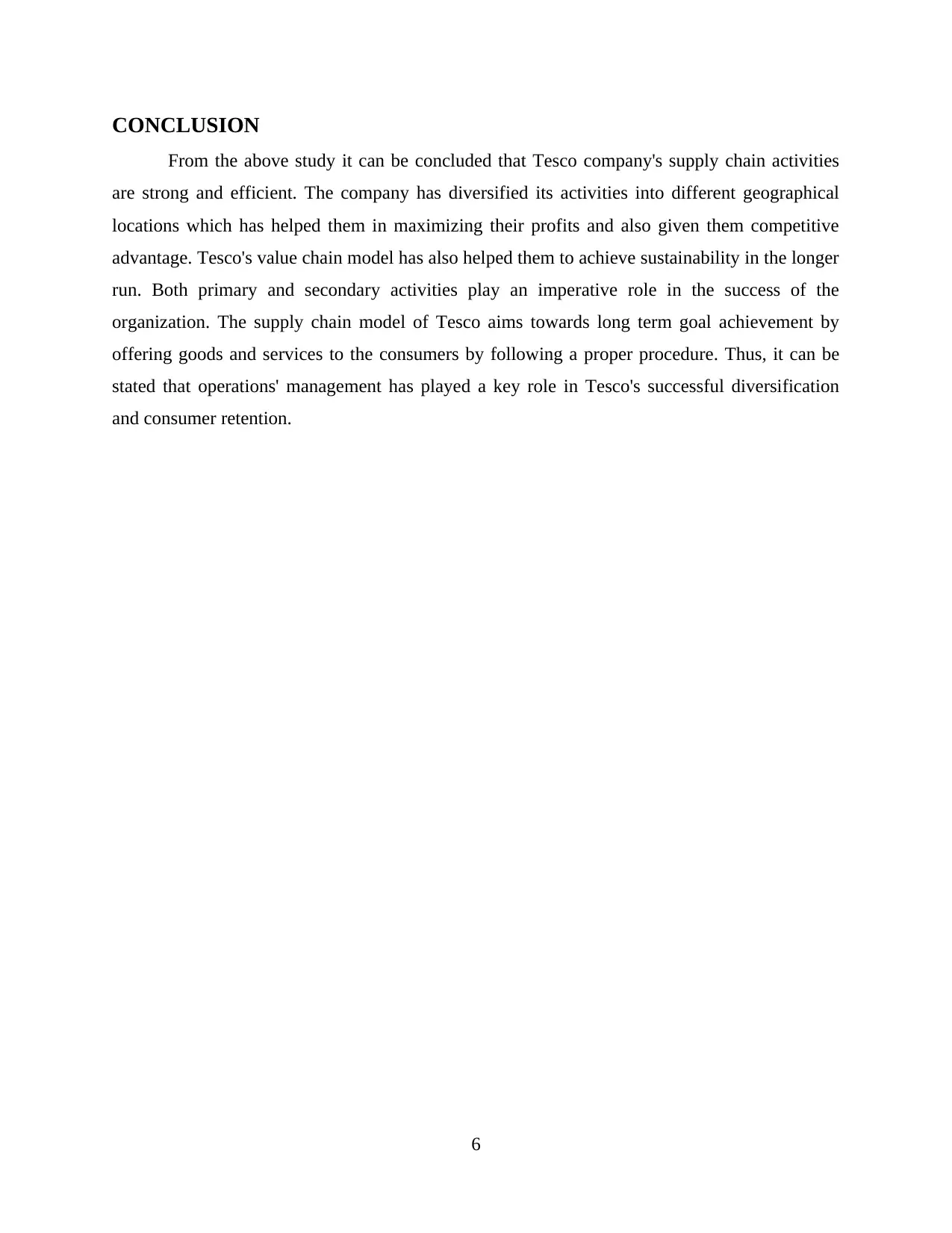
CONCLUSION
From the above study it can be concluded that Tesco company's supply chain activities
are strong and efficient. The company has diversified its activities into different geographical
locations which has helped them in maximizing their profits and also given them competitive
advantage. Tesco's value chain model has also helped them to achieve sustainability in the longer
run. Both primary and secondary activities play an imperative role in the success of the
organization. The supply chain model of Tesco aims towards long term goal achievement by
offering goods and services to the consumers by following a proper procedure. Thus, it can be
stated that operations' management has played a key role in Tesco's successful diversification
and consumer retention.
6
From the above study it can be concluded that Tesco company's supply chain activities
are strong and efficient. The company has diversified its activities into different geographical
locations which has helped them in maximizing their profits and also given them competitive
advantage. Tesco's value chain model has also helped them to achieve sustainability in the longer
run. Both primary and secondary activities play an imperative role in the success of the
organization. The supply chain model of Tesco aims towards long term goal achievement by
offering goods and services to the consumers by following a proper procedure. Thus, it can be
stated that operations' management has played a key role in Tesco's successful diversification
and consumer retention.
6
Paraphrase This Document
Need a fresh take? Get an instant paraphrase of this document with our AI Paraphraser
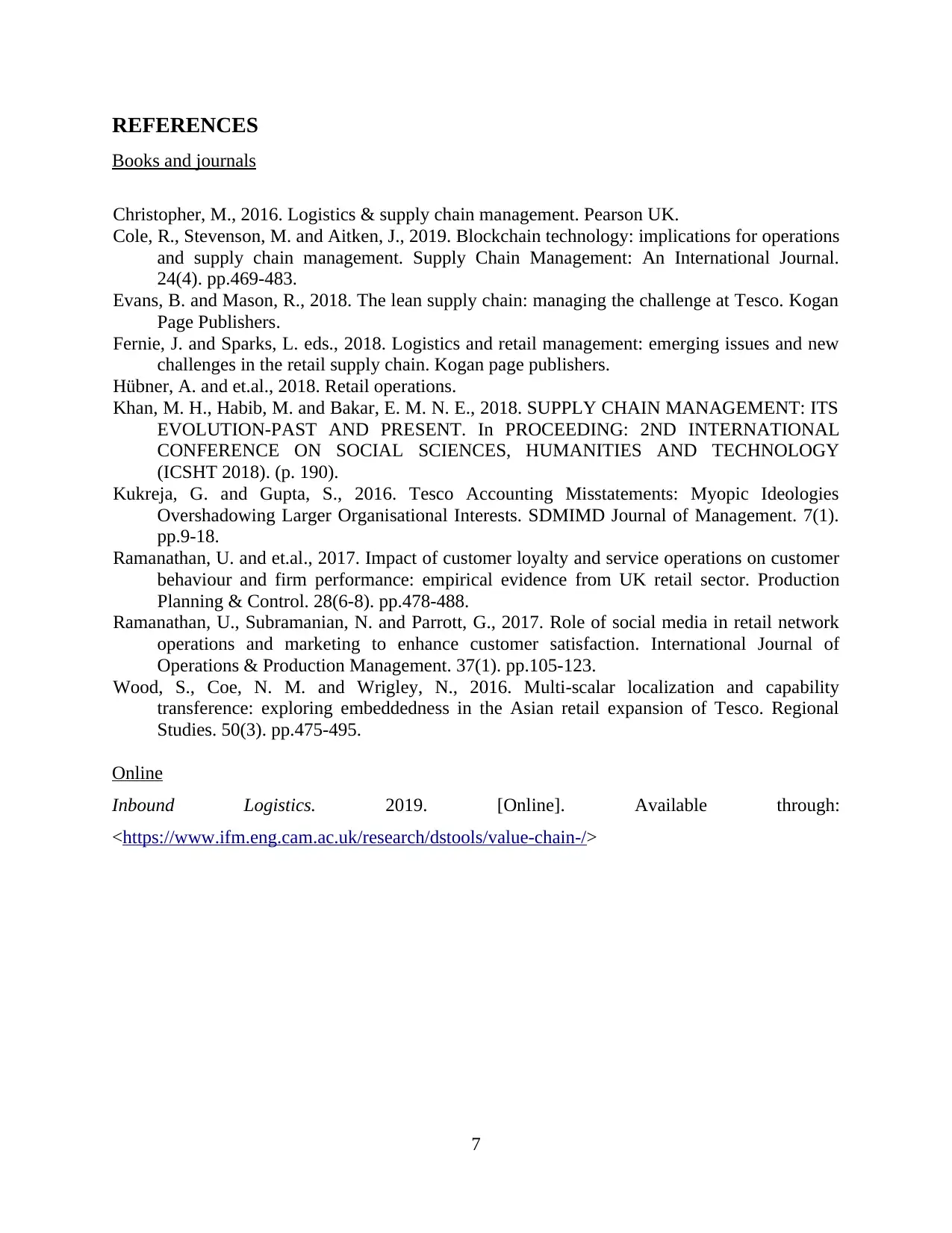
REFERENCES
Books and journals
Christopher, M., 2016. Logistics & supply chain management. Pearson UK.
Cole, R., Stevenson, M. and Aitken, J., 2019. Blockchain technology: implications for operations
and supply chain management. Supply Chain Management: An International Journal.
24(4). pp.469-483.
Evans, B. and Mason, R., 2018. The lean supply chain: managing the challenge at Tesco. Kogan
Page Publishers.
Fernie, J. and Sparks, L. eds., 2018. Logistics and retail management: emerging issues and new
challenges in the retail supply chain. Kogan page publishers.
Hübner, A. and et.al., 2018. Retail operations.
Khan, M. H., Habib, M. and Bakar, E. M. N. E., 2018. SUPPLY CHAIN MANAGEMENT: ITS
EVOLUTION-PAST AND PRESENT. In PROCEEDING: 2ND INTERNATIONAL
CONFERENCE ON SOCIAL SCIENCES, HUMANITIES AND TECHNOLOGY
(ICSHT 2018). (p. 190).
Kukreja, G. and Gupta, S., 2016. Tesco Accounting Misstatements: Myopic Ideologies
Overshadowing Larger Organisational Interests. SDMIMD Journal of Management. 7(1).
pp.9-18.
Ramanathan, U. and et.al., 2017. Impact of customer loyalty and service operations on customer
behaviour and firm performance: empirical evidence from UK retail sector. Production
Planning & Control. 28(6-8). pp.478-488.
Ramanathan, U., Subramanian, N. and Parrott, G., 2017. Role of social media in retail network
operations and marketing to enhance customer satisfaction. International Journal of
Operations & Production Management. 37(1). pp.105-123.
Wood, S., Coe, N. M. and Wrigley, N., 2016. Multi-scalar localization and capability
transference: exploring embeddedness in the Asian retail expansion of Tesco. Regional
Studies. 50(3). pp.475-495.
Online
Inbound Logistics. 2019. [Online]. Available through:
<https://www.ifm.eng.cam.ac.uk/research/dstools/value-chain-/>
7
Books and journals
Christopher, M., 2016. Logistics & supply chain management. Pearson UK.
Cole, R., Stevenson, M. and Aitken, J., 2019. Blockchain technology: implications for operations
and supply chain management. Supply Chain Management: An International Journal.
24(4). pp.469-483.
Evans, B. and Mason, R., 2018. The lean supply chain: managing the challenge at Tesco. Kogan
Page Publishers.
Fernie, J. and Sparks, L. eds., 2018. Logistics and retail management: emerging issues and new
challenges in the retail supply chain. Kogan page publishers.
Hübner, A. and et.al., 2018. Retail operations.
Khan, M. H., Habib, M. and Bakar, E. M. N. E., 2018. SUPPLY CHAIN MANAGEMENT: ITS
EVOLUTION-PAST AND PRESENT. In PROCEEDING: 2ND INTERNATIONAL
CONFERENCE ON SOCIAL SCIENCES, HUMANITIES AND TECHNOLOGY
(ICSHT 2018). (p. 190).
Kukreja, G. and Gupta, S., 2016. Tesco Accounting Misstatements: Myopic Ideologies
Overshadowing Larger Organisational Interests. SDMIMD Journal of Management. 7(1).
pp.9-18.
Ramanathan, U. and et.al., 2017. Impact of customer loyalty and service operations on customer
behaviour and firm performance: empirical evidence from UK retail sector. Production
Planning & Control. 28(6-8). pp.478-488.
Ramanathan, U., Subramanian, N. and Parrott, G., 2017. Role of social media in retail network
operations and marketing to enhance customer satisfaction. International Journal of
Operations & Production Management. 37(1). pp.105-123.
Wood, S., Coe, N. M. and Wrigley, N., 2016. Multi-scalar localization and capability
transference: exploring embeddedness in the Asian retail expansion of Tesco. Regional
Studies. 50(3). pp.475-495.
Online
Inbound Logistics. 2019. [Online]. Available through:
<https://www.ifm.eng.cam.ac.uk/research/dstools/value-chain-/>
7

8
⊘ This is a preview!⊘
Do you want full access?
Subscribe today to unlock all pages.

Trusted by 1+ million students worldwide
1 out of 9
Related Documents
Your All-in-One AI-Powered Toolkit for Academic Success.
+13062052269
info@desklib.com
Available 24*7 on WhatsApp / Email
![[object Object]](/_next/static/media/star-bottom.7253800d.svg)
Unlock your academic potential
Copyright © 2020–2025 A2Z Services. All Rights Reserved. Developed and managed by ZUCOL.





